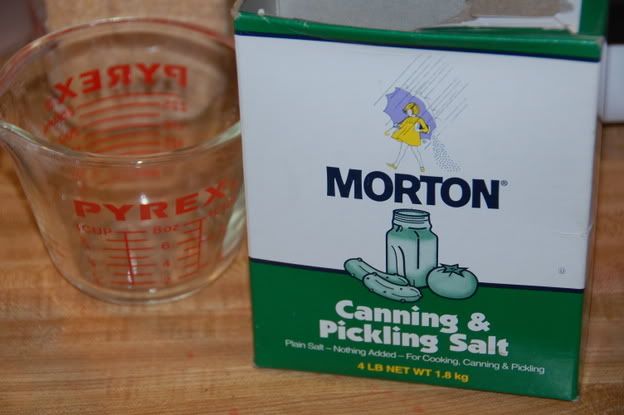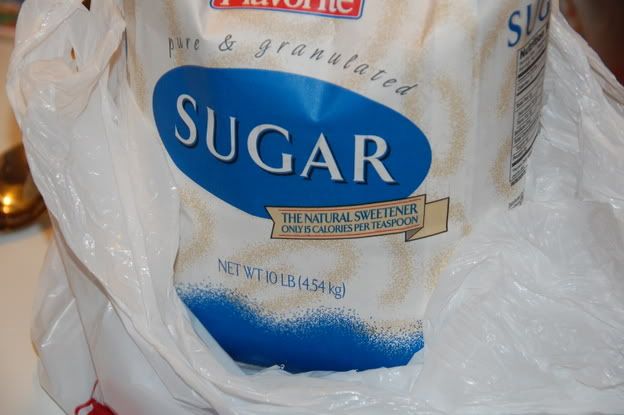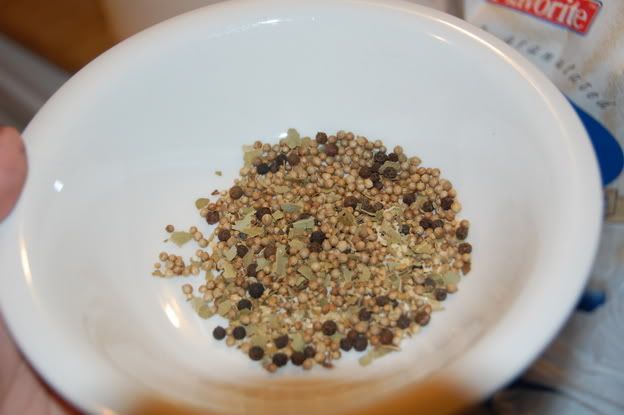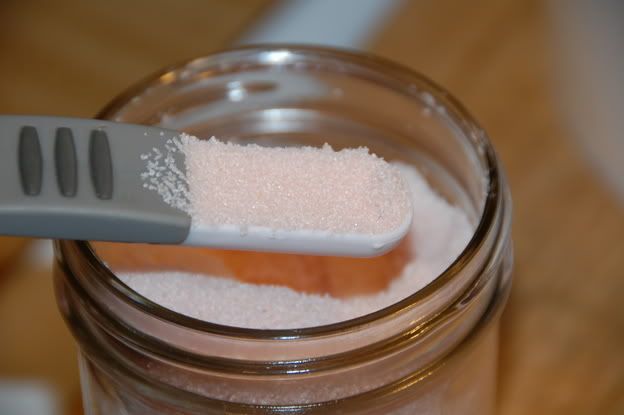Maija was asking for "Alaskan" recipes today and that made me realize I had forgotten to blog about corned moose. I meant to post it in July the first time I made it.

Corning meat is not a very complicated process, but it does take a while. First you need a container to make it in. I use a food grade 2 gallon plastic bucket that has a lid. Fill the bucket with 1/2 gallon of hot water.

Add 1 cup kosher salt to the hot water and stir until it is dissolved. When the salt is dissolved add 1/2 gallon of cold water.

Then add 1/4 cup of sugar...

1/8 cup of pickling spices...

...and one teaspoon of Prague Powder. Prague powder is also sometimes called "Insta-cure #1" and it can be purchased at places that sell sausage making supplies. You can also use Morton Tender Quick. Prague Powder is 6.25 percent sodium nitrite. Sodium nitrite is what prevents you from whipping up a jolly good batch of botulism while you are corning your meat. It also helps it retain that pleasing pink color after you cook it. I know, I know, nitrites are supposed to be bad for you but really, you probably have to eat a ton of it all the time before it kills you and botulism will kill you lickity split. I'm not a doctor....but I did once stay at a Holiday In Express.

All those ingredients that you have mixed into the bucket are your brine. This is what you are going to soak your meat in. Now you can use just about any red meat you want, moose, caribou, musk ox, whatever. I have also heard of people corning duck or goose breasts, but I have never tried that.
Whatever you decide to corn try and use pieces of like size. for example I was able to fit four equal sized pieces of meat (not sure how much they weighed) into my bucket. The general rule is that for every inch of meat thickness you need to keep it in the brine for 3 days. So if your roasts are 5 inches thick you need to soak them in the brine for 15 days.
So put as many roasts as you can into the bucket while still having enough room to ensure that they stay submerged. You can keep them submerged by weighing them down with a heavy plate or bowl. Put the lid loosely on the bucket and place the bucket in your fridge. Make sure you move the meat around and stir the brine ever couple days. When the roasts are done brining you can freeze them until your ready to eat them. You cook it as you would any corned beef that you buy at the store. I know it sounds like a lot of work but it really isn't. Give it a try.
.


9 comments:
YUMMM!!!
That sounds good, you are funny, and I am too lazy to sign in!
Trish
That sure is interesting!
Is this the part where I say thank you for such a corny piece?
Well done, and thanks
CornDog
Awesome...I'm including it in my book! :)
And I want to try a piece...or sell me some prauge powder! haha.
That's really interesting. Very nicely done! Down in Oklahoma, we don't corn meat, we barbeque it!
Liz
Another fascinating tidbit about life in Alaska. This should go in your book!
do you know how to make it so you don't have to freeze it? could that brine also work as part of a fermenting process so it can be canned?
Maija, when I ordered the prague powder it came in a 1lb bag. I figure it will take a long time to use that up one teaspoon at a time so bring a ziploc and I will give you some.
Well, during the canning process you would be using a pressure cooker right? This is what I would do. Take the meat out of the brine and boil it for about 1 hour. Doing that will help desalt the meat a bit and it will also help to reduce meat shrinkage. Cut the meat into chunks and fill to within 1/2 inch of the top of the jar. Add a bit of water or water and put the lid on and then process the jar in the pressure cooker for the allotted time for jar size. I think that would work fine.
Post a Comment